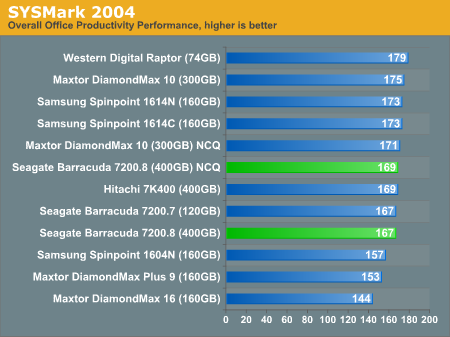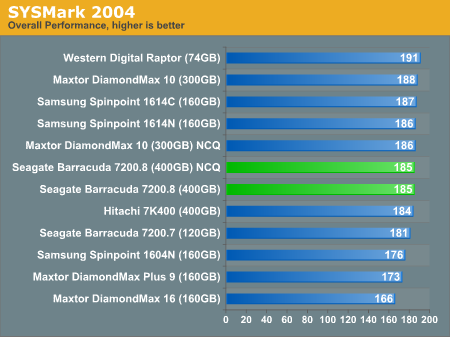Seagate Barracuda 7200.8: 400GBs with NCQ
by Purav Sanghani on April 20, 2005 4:30 PM EST- Posted in
- Storage
SYSMark 2004 Performance Summary
These scores represent the overall performance of each component of SYSMark 2004.The overall Content Creation performance results are, again, too close to make any decision on which drive performs better here. We will instead focus on the Communication portion of SYSMark's Office Productivity suite.
To recap, here's what happens in the entire Office Productivity suite:
"In this scenario, the office productivity user creates a marketing presentation and supporting documents for a new product. The user receives email containing a collection of documents in a compressed file. The user reviews his email and updates his calendar while a virus checking software scans the system. The corporate web site is viewed and the user begins creating the collateral documents. The user also accesses a database and runs some queries. A collection of documents are compressed. The queries' results are imported into a spreadsheet and used to generate graphical charts. The user then transcribes a document. Once the document has all the necessary pieces in place, the user changes it into a portable format for easy and secure distribution. The user edits and adds elements to a slide show template. Finally, the user looks at the results of his work (both the slide show and the portable document) in an Internet browser."












44 Comments
View All Comments
zforgetaboutit - Thursday, May 26, 2005 - link
The review has a table showing the drives' spec sheets. Among the stats are "average seek times (AST)". But I don't see average seek times benchmarked, as such.So, on the one hand, the Seagate's spec shows an AST of 8.x seconds, but other reviews have shown it to be 11+ seconds.
I propose that if the review goes as far as to publish the purported AST, then it has an obligation to test it as well, with a discrete benchmark, such as HDTach or some other explicit AST benchmark.
Otherwise companies will start to claim 2 ms AST, and Anandtech won't be able to refute it, if it's a blatantly bogus claim.
OrSin - Tuesday, April 26, 2005 - link
I see you explain how you take your sound measurements, but you really need to do it differently. The raptors are load as hell and seagate are queit and accourding to measure they are equal? Serious I undestand your reasoning for it, but it's just flawed. If a test seems right but produces obviously (and I mean obviously) wrong results then you need a new method.I had to send a raptor back it was so loud. I had to look at my computer (SFF) evertime i booted up to make sure it was going to rock off the table. Now my computer was a not actually moving but it sounding like it vibrating enough to move.
Zak - Monday, April 25, 2005 - link
Your articles are often difficult to read due to your use of some weird convoluted sentence structure. Why can't you guys use simpler, more accessible language??? Exampple:"RPM, or revolutions per minute, is the measure of instances that the motor of the hard drive can rotate the platters by a full 360 degrees."
How about:
"RPM, or revolutions per minute, the speed of platter rotation: how many times the platters rotate every minute." or something like that.
Zak
JPSJPS - Monday, April 25, 2005 - link
Purav Sanghani - Poster 32 and especially poster 33 pointed out an obvious mistake that only a complete newbie would make. This makes all of your data questionable!!! Have you considered having someone with a little technical knowledge review your stuff before you publish it?PuravSanghani - Friday, April 22, 2005 - link
TrogdorJW: The recordings as well as decibel readings were taken 1" away from the side of each drive. Obviously the sound emitted from the drives would not be as loud when inside a sealed case, but to get an accurate reading of the sound emissions from each drive and comparing them to each other requires that we take readings close to each unit.smn198: You are right, the frequency of the sound produced by each drive does make a world of difference. In the past when looking at case fans, we observed that larger 120mm fans are quieter than smaller 80mm fans because they produce a lower frequency which is less noticeable to humans. This is definitely the case with anything that produces any sound, including hard drives.
ohnnyj - Friday, April 22, 2005 - link
I want to know how you get Photoshop to open in under seven seconds on a Raptor. My RAID0 array opens in about 14-15. It opens faster if you open, close, then reopen again so I wonder if this is how the test was performed.Phantronius - Friday, April 22, 2005 - link
Just bought 2 160gig Barracuda's to replace my noisey as hell Western Digitals. I freaking love them, soooooo much quieter.TrogdorJW - Thursday, April 21, 2005 - link
A few things to note on noise (from my perspective):1) The hard drive noise levels were probably taken very close to the drives in order to capture them. Just FYI. 52 to 54 dBA is rather loud. Purav, what was the distance of your SPL meter from the drives?
2) Seek noise can be very noticeable. My own experience reflects what's in the charts, with the Samsung being the quietest. Seagate and Hitachi are moderately loud, and the Maxtor and Western Digital Raptor are the loudest. (Raptor seek noise sounds louder to me than what's in the recordings.) I don't know about the decibel ratings, but it seems like if you started the charts at 50 that it would reflect more what I hear. (i.e. Samsung would be 1.2 to 2.4 and Hitachi would be 1.6 to 4.4)
3) Bearing noise is generally either near-silent (Samsung, Seagate, and just about any other FDB implementation, including the Raptors) or else it's noticeable. The WDxxxxBB/JB models are notorious for having a lot of bearing noise, as are older Maxtor drives. I've got four WD's at my place, and I hate them all! :-p (They're a bit faster in a lot of tests, but they're too noisy.)
4) Ignoring the echo in the recordings (MP3 compression can cause some funky artifacts), listen to the Maxtor 10 - Ouch! That thing is killer loud.
JonB - Thursday, April 21, 2005 - link
Since my motherboard SATA controllers don't support NCQ, I have three choices. Leave it disabled (which doesn't seem so bad in some respects), get a new motherboard, or add a Promise or Adaptec PCI controller card.Anybody got experience with an add-in Promise RAID with NCQ support???
smn198 - Thursday, April 21, 2005 - link
#28 - "Maybe we're seeing no boost with NCQ because of poor implementation, who knows. Testing with just one platform will not reveal such issues."I seem to remember Anand saying the opposite
http://www.anandtech.com/cpuchipsets/showdoc.aspx?...
"What's truly impressive, however, is the reduction in average response time - up to a 90ms decrease in response time, thanks to NVIDIA's superior NCQ implementation. "
However, Anand did mention that NVIDIA took the decision not to 'turn on' NCQ until the queue depth had exceeded a certain amount. (Cannot remember which article that was in.) It may be that in some of these tests, this queue depth was not exceeded.
#30 - "How is the 7200.7 120Gb drive louder then a Raptor? My 7200.7 120Gb drive is near SILENT, no where loud as a Raptor. I think your measuring device is off forthe Acoustics test."
This may be due to the fact that the noise the Raptor emits is at a different, more audible frequency.